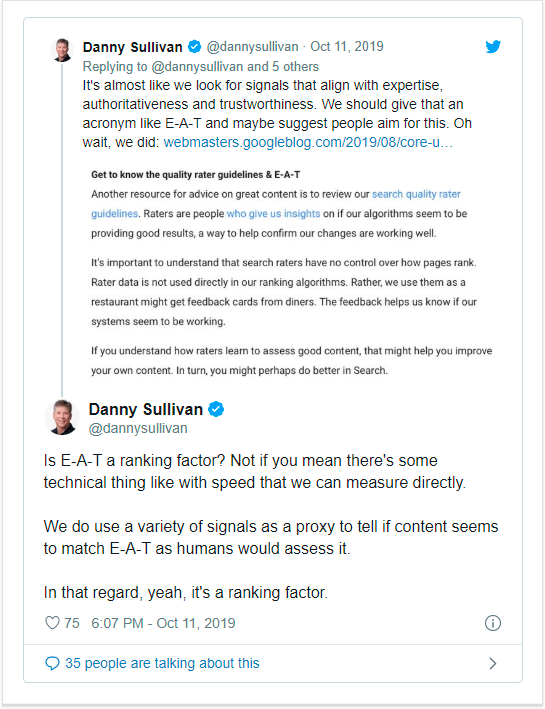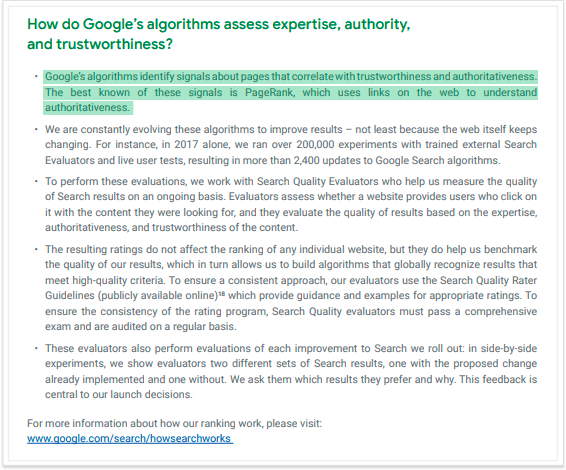19899
•
11-minute read


You might have heard of E-A-T. You must have heard of E-A-T. It appeared seemingly out of nowhere and became one of the hottest SEO topics of the past two years. And the funny thing is, for all the talk of E-A-T, there is hardly ever a straight answer as to what it is and if it actually matters. In fact, here are the first two results you get when trying to google whether E-A-T is a ranking factor:

So, following is a brief account of what's the story behind E-A-T, why are people obsessed with it, and whether you should be one of them.
Expertise, Authority, and Trustworthiness (E-A-T) are the criteria Google considers to be indicative of page quality. Those and other criteria are frequently mentioned in the Quality Raters' Guidelines — the instructions given to human raters for evaluating the quality of search results.
E-A-T is said to be important for all content, but especially for the content that has the potential to impact a person's future happiness, health, financial stability, or safety. Google calls such pages "Your Money or Your Life" pages, or YMYL.
To establish E-A-T, raters are instructed to explore the information available on the page itself, as well as the information available elsewhere on the website and on the web in general. There are about a dozen quality signals that they have to look for, but not all of those signals are present for all types of content, so raters are often left to make a judgment call on the final E-A-T rating.
The content has to be produced by an individual or an organization with experience, education, or other qualifications relevant to the topic of the content. Importantly, not all types of content require formal expertise — for non-YMYL pages, life experience can be sufficient. In the below example of a Quora page, though the topic is medical, it asks not for medical advice, but for personal experience, for which no formal expertise is required.

Expertise can be established through the author of the content. Things to look for are credentials, bio, author page, number of articles on this or similar subjects, articles on other websites, or perhaps a part of the content that explains how the author came to be an expert on the subject.
Expertise can also be established through the website or the organization behind it. US Naval Observatory, for example, is probably an expert on time zones, a restaurant is an expert enough for its own About page, and a furniture company is an expert on its own furniture.
Sometimes, expertise can be self-evident from the quality of the content. If it's a detailed piece of appropriate length, with plenty of examples and references, then raters may conclude that the content is created with sufficient expertise.
For a piece of content to have authority, the expertise of the content creator has to be recognized by others in the same field and by the audience at large. This is why to evaluate authority, raters have to look beyond the website where the content is located.
The main advice raters get on evaluating authority is to google the author or the organization while excluding the sources that are maintained by the author or by the organization in question. Signals to look for are awards, reviews and ratings, expert opinions, and mentions by other organizations. Wikipedia is often cited as a reliable source of such information, like in the example below:

Trustworthiness is a multifaceted concept that includes factual accuracy of the information, transparency about the organization behind the website and its policies, and the reputation of the content creator.
To evaluate trustworthiness, raters are instructed to have a look around the original website and see whether it has things like company description, terms and conditions page, refund policy, contact information, and other relevant formalities.
It is also important to check whether the content itself can be trusted — whether the facts are recent, whether YMYL claims are supported by references (which is one of the YMYL factors), and whether the content is in alignment with the scientific consensus. Below is an example of a page that goes against the scientific consensus and would probably get the lowest trustworthiness score.

I felt it necessary to include this in the article because when reading about E-A-T one would easily get the impression that it is the central concept in the Quality Raters Guidelines and the main criteria for page quality. Not so.
Evaluating E-A-T is just one of the steps when assessing page quality. Raters start by establishing the purpose of the page, after which they try to determine whether the page can be trusted (E-A-T), then they look at the quality of the main content, and, finally, check whether the page provides a good user experience.
If anything, I would say that the importance of E-A-T has diminished in the latest edition of the raters' guidelines, as the number of times the concept is mentioned in the document has gone down to 135, from 186 in the previous edition.
The concept of E-A-T had appeared in 2013 and had led a reasonably unremarkable existence until its sudden shot to fame in 2018. But, for the sake of being thorough, let's start even further back:
Probably even as early as 2003, there are rumors on the web about Google organizing some kind of Rater Hub and drafting regular internet users to work as quality raters and review its search index.
The instructions given to quality raters are leaked for the first time and, though insightful, contain only the most basic of page quality parameters that mostly have to do with content relevance.
After a number of subsequent leaks, Google finally decides to make the guidelines public, except it turns out that the public version is much much shorter than the leaked one. This is also the year the document first mentions E-A-T.
Google finally releases the full version of the guidelines to the public and from this point on SEOs are fully aware of E-A-T, but it doesn't yet become as much of a concern as it is today.
On August 1st, Google releases a major algorithm update, and all over the web, the organic traffic goes haywire. SEO experts rush to find the fix and restore their rankings. They bug Google about it relentlessly, but Google insists this is a broad update and there is no specific thing to fix. Until Danny Sullivan, Google's public liaison of search, gives us a hint about something we might try — use Quality Rater's Guidelines to make better content.

For all intents and purposes, this was probably a generic comment meant to calm the community down, but a lot of people took it to heart. In the early days of the update, it seemed like medical websites were disproportionately affected, and in the raters' guidelines, medical websites are specifically referenced as the ones held to the highest quality standard. So it was easy to assume that the update and the guidelines were directly connected.
That's when SEO experts began mining rater's guidelines for actionable fixes and, though the guidelines contained dozens of page quality metrics, they've landed specifically on E-A-T. And it kind of made sense, because prior to that no one really paid attention to E-A-T, so it was one area of the guidelines where SEOs could see the biggest room for improvement.
From that point on, E-A-T had been gaining popularity in the SEO community, where it is now preached both as a way to recover from the August update and a way to gain better rankings in general.
Yes and no. The concept of E-A-T includes over a dozen factors that would indeed improve page quality, but only as perceived by human quality raters and users in general. There has never been any proof that E-A-T can be measured algorithmically.
In fact, Google straight out told us that it can't:

Furthermore, Google representatives have, at various points, confirmed that they can't, or rather won't, track various individual signals considered to be a part of E-A-T:
On author reputation, John Mueller had commented:
I wouldn't look at the Quality Rater Guidelines as something that is like our algorithms are looking at explicitly, checking out the reputation of the authors and then using that to rank your websites.
On business reviews, John Mueller had commented:
"We wouldn't use something like a BBB score for something like this. There are various kinds of issues with regards to some of these sources of information about a business, about a website, and we need to make sure that we are really reflecting what we think is actually relevant for users rather than blindly relying on some third party ratings."
On fact-checking, it is said in Google's whitepaper on fighting disinformation:
"Our ranking system does not identify the intent or factual accuracy of any given piece of content."
On content recency, John Mueller had commented:
"Freshness is always an interesting one because it's something that wouldn't be… we don't always use it because sometimes it makes sense to show people content that has been established, looking at kind of long-term research, and some of this stuff just hasn't changed for years. Sometimes we just have content that looks to us like it remains relevant."
On grammar, John Mueller had commented:
"It's always good to fix known issues with a site, but Google's not going to count your typsos."
On social signals, Gary Illyes had commented:
"It was funny because there was an SEO that said: "Ok, we see a lot of likes on Facebook, and those are the pages that rank well…" But that's correlation, that's not causation. Instead, it's probably that there is something really awesome, and because there is something awesome, then it gets a lot of likes on Facebook, and a lot of people decide to link to it. That's the sort of thing where the better content you make the more people are gonna like it not only in Google but on Twitter and Facebook as well."
That being said, Google does use one signal that points to E-A-T, but this is not the same signal that they talk about in Quality Raters Guidelines. Here is an excerpt from a whitepaper on How Google Fights Disinformation:

To everyone's disappointment, the signal Google uses to determine E-A-T algorithmically is the oldest one in the book — PageRank, aka backlinks, aka the number and the quality of links pointing to your page from other sources. Backlinks are something every SEO expert has been working on long before there was even a notion of E-A-T, so there is really nothing new to account for.
It depends on your goal.
If you want to give your page a boost in rankings, then no, optimizing for E-A-T is not going to help you do that. From what Google says about the use of E-A-T signals and from the way quality raters are instructed to evaluate E-A-T, we can say with some confidence that there is no way yet to determine E-A-T algorithmically. So, whatever E-A-T optimization you do, Google is unlikely to "see" it.
Absolutely. Quality Rater Guidelines contain a ton of great advice, E-A-T or otherwise, on improving page quality. It might not be registered by the algorithm, but it will definitely go towards better user experience and smoother business processes. Those things will, in turn, increase the value of your content and will contribute to your rankings indirectly. Just don't make it into an SEO strategy — if rankings are your primary concern, then, again, there are probably better things to do from a strictly SEO perspective.
Ben Gomes, Google VP of Search Engineering, had said that even though raters guidelines are not how the algorithm works today, it is an accurate reflection of where it wants to go in the future. And with a fine-tuned PageRank, a patent on cataloging named entities, and an army of 16,000 quality raters guiding thousands of algorithm adjustments per year, it is pretty much guaranteed that one day Google will be able to assess all of the E-A-T criteria accurately.
It is also pretty much guaranteed that by the time Google introduces an E-A-T score to its algorithm, you won't be able to fool it by displaying E-A-T, you would actually have to have it. So, in this regard, it is not a bad idea to start optimizing for E-A-T today. Not in a superficial way of adding a page element here and there, but by actually building a positive reputation for your brand, your authors, and your products. Which is probably no different from what you'd be doing anyway.
Even though the claims about E-A-T being a ranking factor are mostly unsubstantiated, it still persists as a popular topic in the SEO community. Not that it's malicious in any way — most E-A-T optimization advice is actually good advice in general. Still, I believe most of us would rather deal with proven SEO concerns than chase a very unlikely 'maybe'. To that end, the only proven SEO concern that has to do with E-A-T is page and site authority drawn from backlinks.

By: Andrei Prakharevich